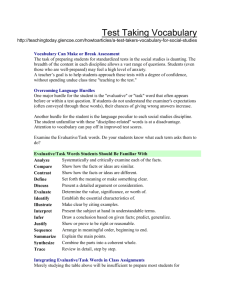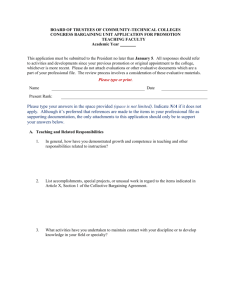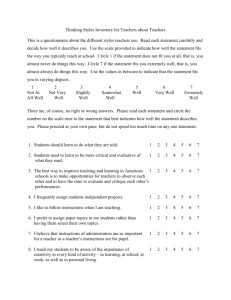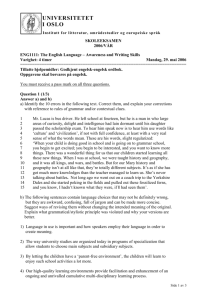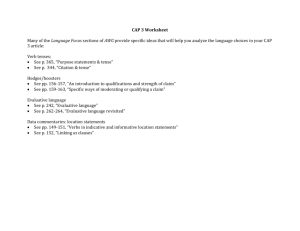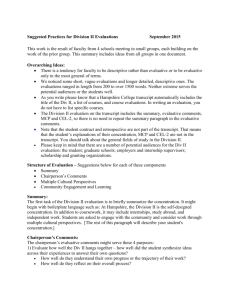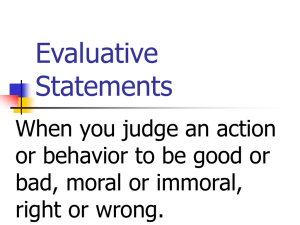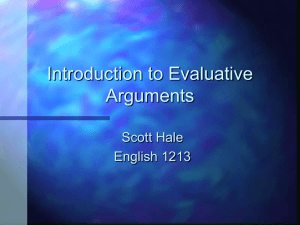Evaluation and Collaboration
advertisement
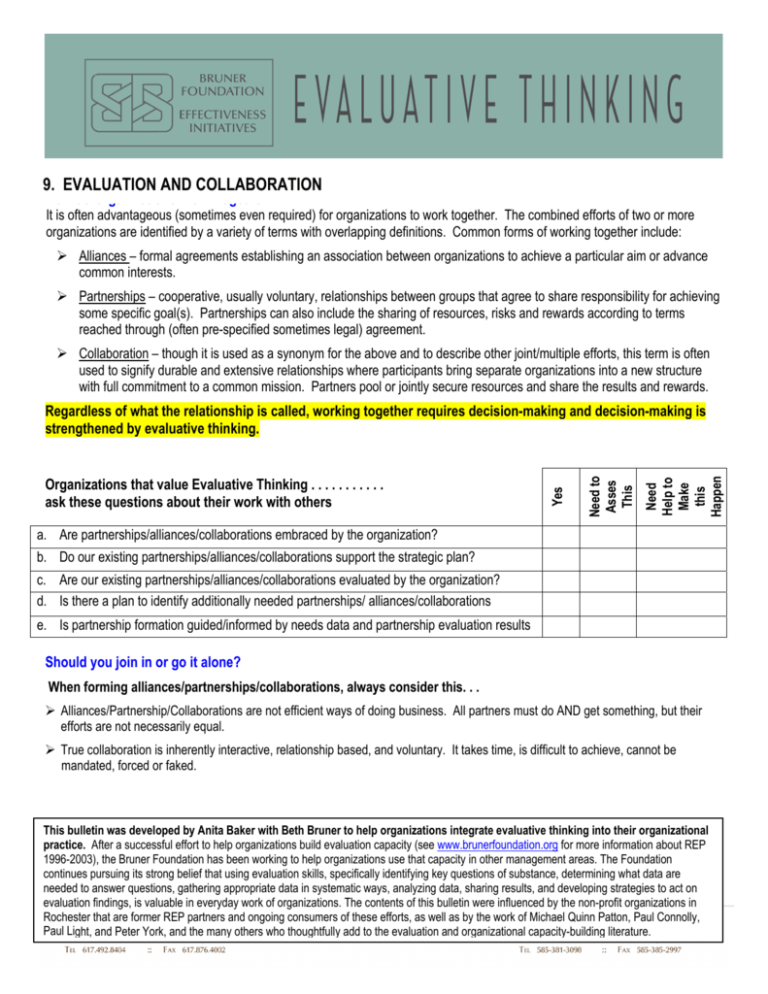
9. EVALUATION AND COLLABORATION How do Organizations Work Together? It is often advantageous (sometimes even required) for organizations to work together. The combined efforts of two or more organizations are identified by a variety of terms with overlapping definitions. Common forms of working together include: ¾ Alliances – formal agreements establishing an association between organizations to achieve a particular aim or advance common interests. ¾ Partnerships – cooperative, usually voluntary, relationships between groups that agree to share responsibility for achieving some specific goal(s). Partnerships can also include the sharing of resources, risks and rewards according to terms reached through (often pre-specified sometimes legal) agreement. ¾ Collaboration – though it is used as a synonym for the above and to describe other joint/multiple efforts, this term is often used to signify durable and extensive relationships where participants bring separate organizations into a new structure with full commitment to a common mission. Partners pool or jointly secure resources and share the results and rewards. Need Help to Make this Happen Need to Asses This Organizations that value Evaluative Thinking . . . . . . . . . . . ask these questions about their work with others Yes Regardless of what the relationship is called, working together requires decision-making and decision-making is strengthened by evaluative thinking. a. Are partnerships/alliances/collaborations embraced by the organization? b. Do our existing partnerships/alliances/collaborations support the strategic plan? c. Are our existing partnerships/alliances/collaborations evaluated by the organization? d. Is there a plan to identify additionally needed partnerships/ alliances/collaborations e. Is partnership formation guided/informed by needs data and partnership evaluation results Should you join in or go it alone? When forming alliances/partnerships/collaborations, always consider this. . . ¾ Alliances/Partnership/Collaborations are not efficient ways of doing business. All partners must do AND get something, but their efforts are not necessarily equal. ¾ True collaboration is inherently interactive, relationship based, and voluntary. It takes time, is difficult to achieve, cannot be mandated, forced or faked. This bulletin was developed by Anita Baker with Beth Bruner to help organizations integrate evaluative thinking into their organizational practice. After a successful effort to help organizations build evaluation capacity (see www.brunerfoundation.org for more information about REP 1996-2003), the Bruner Foundation has been working to help organizations use that capacity in other management areas. The Foundation continues pursuing its strong belief that using evaluation skills, specifically identifying key questions of substance, determining what data are needed to answer questions, gathering appropriate data in systematic ways, analyzing data, sharing results, and developing strategies to act on evaluation findings, is valuable in everyday work of organizations. The contents of this bulletin were influenced by the non-profit organizations in Rochester that are former REP partners and ongoing consumers of these efforts, as well as by the work of Michael Quinn Patton, Paul Connolly, Paul Light, and Peter York, and the many others who thoughtfully add to the evaluation and organizational capacity-building literature. Before establishing a partnership/collaboration/alliance, try to answer these questions: ¾ Why is a combined approach better – what are the enhanced outcomes? ¾ Do you really need partners to accomplish what you want to do? ¾ Who will be involved and how? What is your organization’s history of and commitment to partnerships? ¾ How will the collaborative operate? (administration, communication, record-keeping, decision-making) ¾ What is the time frame for the collaborative work? How much time will be required for start-up, maintenance, disassociation and how much will be dedicated to overseeing and nurturing the partnership? ¾ How will you evaluate the effectiveness of your collaboration and use evaluation findings to strengthen it? ¾ What is required to make your partnerships/alliances/collaborations work? The Rochester Effectiveness Partnership (REP) prospered for more than seven years as an active partnership. The following list, derived from evaluation interviews with key REP stakeholders, identifies some of the important features that made it work and that we believe should define all active partnerships. Partnership Must-Haves Ö Clearly articulated rationale for creating the partnership. A decision to develop the partnership rather than “go it alone.” Ö Strong visible funding champion/s who is committed for the long haul (minimum of 3 – 5 years) Ö Willing participants – no implicit or explicit coercion Ö Equity among partners Ö Mutually agreed upon outcomes/impacts Ö Clarity about roles, commitment, expectation on the front end Ö Adequate resources – both time and money Ö Time on the front end to establish trust, communication and mechanisms, operational logistics Ö Strong, competent facilitator/s Ö Mutually agreed upon evaluation plan Ö Commitment to transparency and mid-course alterations as needed Partnership Benefits (Why is it worth it?) ¾ ¾ ¾ ¾ ¾ ¾ Multiple perspectives and access Multiplied financial resources Leverage of investments Relationship building Shared “risk” Opportunities for involvement with others ¾ More equitable power distribution ¾ ¾ ¾ ¾ ¾ ¾ ¾ Partnership Challenges (Why is it Difficult?) Power sharing Organizational buy-in among partners Demanding nature of collaborative scheduling Added time (including time for collaboration) Added costs Management/oversight stresses More equitable power distribution Page 2 How Can Organizations Use Evaluative Thinking When Addressing Business Ventures? In addition to forming partnerships, alliances and collaborations, some organizations may want to take on specific business ventures. Evaluative Thinking will come in handy for this too. When considering business ventures, organizations should: ¾ Develop a plan to cultivate relations with outside agencies or vendors. ¾ Develop a plan to identify gaps in community services. ¾ Assess whether it has the capacity to bring in new business. ¾ Thoroughly research new business venture development prospects. ¾ Develop business venture strategies based on capacity findings, results of gap studies and business venture development research. Monitoring Partnerships Use your evaluative thinking skills to design a strategy to monitor any partnerships. As always: • • • • Ask questions of substance and determine what data are needed to address the questions (i.e., what are important elements of partnership (see below). Gather appropriate data in systematic ways (consider developing a “rubric” or scale to measure how the partnership is developing – see below, then have individual organizational members of the partnership complete the rubric and compare results on an agreed upon schedule). Analyze data and share the results among the partners and other key stakeholders of the partnership. Develop strategies to act on the findings of partnership assessment. For example determine what to do if partners think the partnership is not functioning as well as it should, if there are weak members, a diffuse mission etc. Here are some questions to consider. ¾ Do partners articulate a shared vision for their work? ¾ Are the short and long-term goals, objectives and strategies of the partnership clear to all partners? Are they realistic? Are goals, objectives and strategies revised with new data regularly? ¾ Can most partners articulate how they benefit from participating in the collaboration? Do most support the partnership agenda? ¾ Can most partners articulate how the advantages of membership offset direct and other partnership costs. ¾ Does the partnership have the appropriate and required mix of participants even after there is turnover or membership change? Is there targeted recruitment? ¾ Is there evidence of appreciation and respect for different stakeholder roles and organizational differences? ¾ Is the partnership able to handle difficult discussion and resolve conflict respectfully and consensually? ¾ Are working relationships enhanced by involvement in the partnership? ¾ Are decision making and direction-setting shared by all active members of the partnership? ¾ Are meetings regular, well-organized, well-run? Is attendance consistent? ¾ Are there effective committees and strong leaders for the partnership? ¾ Do all partners clearly understand their roles and responsibilities? Are MOUs (or other formal agreements) and accountability mechanisms in place regarding how the partnership works and what it focuses on? ¾ Do partners formally interact regularly and often? Do they update one another, discuss issues openly and convey all necessary information to one another and to people outside their group? ¾ Do formal and informal communications mechanisms exist? ¾ Do meetings include time for formal discussions? Are most members engaged in meetings and the work of the partnership? How to Use These Bulletins The Integrating Evaluative Thinking Bulletins were developed in response to the continuing need expressed by nonprofit partners to clarify how to enhance evaluative thinking and put enhanced evaluation capacity to work. The bulletins are intended to do the following: • Clarify what evaluative thinking is, why it is important, and who can do it. • Provide direction regarding the use of the Bruner Foundation’s Evaluative Thinking Assessment Tool to inform action plans that will enhance evaluative thinking. • Describe additional ways that evaluation strategies can be used internally to increase evaluative thinking (e.g., evaluating the effectiveness of staff development efforts or collaborative ventures). • Help organizations think about creative ways to present and use evaluation findings. • Provide practical advice on how to hone analytical skills, and use Evaluative Thinking when making decisions about standard organizational procedures including governance, mission development, strategic planning, fund development, leadership, technology, human relations, staff development, alliances and business ventures. There are 11 individual Integrating Evaluative Thinking Bulletins including this edition. They cover the following topics: evaluation basics and definitions, evaluative thinking basics and assessment of evaluative thinking, evaluation and nonprofit boards, commissioning evaluation, collecting, analyzing and using evaluation data, communicating about evaluation, evaluation and technology, evaluation and HR, evaluation and alliances, increasing participation in evaluation and sustaining evaluative thinking. Each bulletin is brief and replete with practical suggestions made by nonprofit partners who reviewed the work (including some very specific pointers highlighted in yellow). A complete set of all Bulletins, as well as other complementary tools and resources are available via the Bruner Foundation website, www.brunerfoundation.org. We encourage all users of the bulletins to: • Familiarize (or re-familiarize) yourself with basic information about evaluation capacity. • Orient yourself regarding the Bruner Foundation’s Evaluative Thinking Assessment Tool and conduct preliminary assessment in your organization. • Develop action plans informed by the suggestions found in the bulletins. • Implement action plans to enhance Evaluative Thinking in your organization. • Use these specific bulletins as reference materials when needed. • Visit the Bruner Foundation website Effectiveness Initiatives pages (www.Brunerfoundation.org), to familiarize yourself with the history behind this effort and to access the tools and resources available there. ** These materials are for the benefit of any 501©3 organization and may be used in whole or part provided that credit be given to the Bruner Foundation. They may NOT be sold or redistributed in whole or part for a profit
